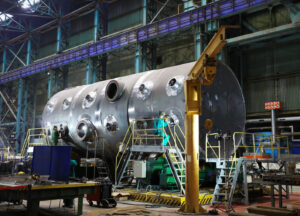Mowdud Rahman & Greig Aitken
As COP21 has reached its endgame, there are plans to build 2,440 coal-fired power plants around the world, write Mowdud Rahman & Greig Aitken. Their completion would send global temperatures, and sea levels, soaring. Yet Bangladesh, the world’s most ‘climate vulnerable’ large country, has plans for a 1.3GW coal power plant on the fringes of its World Heritage coastal wetlands.
On the opening day of the United Nations climate summit in Paris, as a seemingly never-ending array of world leaders lined up to strike the right positive mood music ahead of two weeks of intense negotiating, it was President Anote Tong of Kiribati who spoke for Bangladesh, not the country’s own absent premier Sheikh Hasina.In his address, the leader of the small central Pacific island thanked Fiji for agreeing to take in Kiribati’s population of just over 100,000 people in the event that climate change runs what increasingly seems to be its inevitable course.
Yes, that’s the ever-encroaching grim scenario whereby sea levels will rise to the point where the most vulnerable low lying island states, such as his own, become uninhabitable.
But President Tong also pointedly got to the heart of the matter and reiterated his call for a global moratorium on coal mining. The burning of coal for energy, as most people outside of the industry itself now know and accept, is the number one driver of climate change.
Indeed, there has been no shortage of new reports published during COP 21 explaining the ongoing huge climate threat posed by an ailing industry which has now had to resort to masquerading as a crusader against world poverty – and even the World Bank isn’t buying its claims.
The most stark warning has come from Climate Action Tracker which, in The Coal Gap briefing paper, identifies a staggering 2,440 coal-fired power plants planned globally, both in emerging economies as a suggested means of meeting rapidly increasing electricity demand and also in many states across the EU to replace existing capacity.
“Even with no new construction”, the paper chillingly informs, “emissions from coal-fired power generation in 2030 would still be 150% higher than what is consistent with scenarios limiting warming to below 2°C above preindustrial levels.”
If those 2,440 coal plants get realised, then Global Coal Plant Tracker estimates that the resulting CO2 emissions would exceed the required levels by 400%.
The irrationality of one single planned coal plant
If Bangladesh’s prime minister Sheikh Hasina hadn’t cancelled her attendance at COP 21 for ‘unspecified reasons’ as local media reported, would she have joined Kiribati’s president in urging strong collective solidarity action against the development of coal use? After all, Bangladesh is widely viewed as the nation most at risk from climate change impacts in the coming decades.
The answer is an emphatic ‘No’, and it boils down to the current development in Bangladesh of just one of those 2,440 slated coal power plants.
An isolated case the proposed 1,320MW Rampal coal-fired power plant project may be, but the circumstances under which it is being advanced right now in Bangladesh speak volumes about the reckless logic of coal industry players globally – and about the challenges faced by both local communities in the firing line and campaigners advocating for a drastic scaling up of abundant renewable energy potential.
And that’s without mentioning the impacts where the coal it’s due to burn come from. According to the official environmental impact assessment (EIA), it is planned to import from, variously, Australia, South Africa, or Indonesia. India also could be included in the supply chain in future.
Project of mass destruction
The most immediately alarming aspect of the Rampal project, which the joint venture Bangladesh-India Friendship Power Company Ltd. has already begun constructing, is that the site is located only 14 kilometres from the Sundarbans Reserve Forest. The Sundarbans, stretching over Bangladesh and neighbouring India, is the world’s largest mangrove forest and is also a UNESCO World Heritage Site and biodiversity hotspot.
Speak to seasoned international fossil fuel campaigners about the Rampal project, and even they are floored by the litany of irreversible impacts that will ensue if the smoke ever starts billowing over the Sundarbans.
The power plant and its associated infrastructure, as well as the industrialisation set to follow from it, will – as studies ignored by the Bangladeshi authorities have detailed – lead to an increase in deforestation, river erosion, noise pollution and health hazards, the loss of fisheries, air quality degradation and other severe impacts on the livelihoods of local communities, including impairing the area’s great appeal to tourists.
The Sundarbans is also one of the last remaining habitats for Bengal tigers. According to one recent study, less than 100 individual tigers are believed to be roaming in the Bengali part of the forest (with a similar number on the Indian side), and their numbers are dwindling.
The fragile state of the tiger population and the surrounding biodiversity zone are why the UNESCO World Heritage Committee has expressed its concern for the last two years about the impacts of the coal plant on the “outstanding universal values” of the Sundarbans World Heritage Site, and has asked the Bangladeshi government to halt the project while further studies are undertaken.
What are they building in there?
If the government doesn’t start to co-operate, then there are growing signs that UNESCO will be forced to put Sundarbans on the World Heritage in Danger list. Yet as a recent Channel Four news report on location in the Sundarbans documented, the Rampal project’s construction is under way – only the reporting team were ordered by security guards to stop filming outside the construction site, with no reasons given.
The very real sense that something is not right at Rampal is further evidenced by the involvement of the Indian partner company – the National Thermal Power Corporation (NTPC) – in the joint venture. NTPC, effectively the lead company at Rampal, would not be able to undertake such a project in India because of Indian environmental guidelines that prohibit the construction of coal plants within a 25 kilometre radius of any protected forest.
Such a precautionary approach – and remember that India is generally a very coal-friendly country – is absent in Bangladesh, however. Over the last 12 months, the waterways of the Sundarbans have been blighted by two major cargo vessel spills: one, last December, involved 350,000 litres of fuel oil, and the latest just a few weeks ago resulted in the dumping of 510 tons of coal.
If operations should ever start at Rampal, it’s estimated that it will be burning 4.72 million tons of coal per year – that’s not only bad news for the climate but will also require a major spike in cargo shipping right through some very vulnerable ecosytems.
Yet the Bangladesh government is now in lockdown over Rampal, claiming, as it did in a recent letter to campaigners, “This plant will not impose any threat to ecology, environment, or local people.”
More worryingly, there has been a growing crackdown against Rampal protestors. In October, a demonstration was met by attacks from local goons with police assistance, leaving many protestors injured. Undaunted, increased countrywide resistance is being mobilised by a range of groups.
The National Oil and Gas Committee, a Bangladeshi civil society group, has pledged a re-run in March next year of 2013’s Long March from Dhaka to Dighraj involving 20,000 people, if the government does not call a halt to the Rampal construction.
Post-Paris Rampal decision is looming
We will probably never know for sure why Prime Minister Hasina failed to show up at COP 21. But representing a country at such acute risk from climate change, one with an abundance of alternate power sources such as solar, wind, biomass, biogas, and other low-carbon energy potential, could she have plausibly hoped to omit mention of the mounting Rampal coal plant saga in five minutes of ‘climate-friendly’ oratory?
Could she have side-stepped what Rampal stands atop of and is designed to drive forward – a kamikaze style national power policy which seeks to generate more than 16,000 megawatts (or 50% of total capacity) of electricity from coal burning by 2030?
Perhaps, though, Hasina’s no-show in the French capital can be explained as a response to the public rejection of financial support for the estimated $1.7 billion Rampal project by three French banks earlier this year, warned off by NGO pressure and – no doubt – grave concerns about reputational damage.
A key date in this saga looms in January, when the Rampal joint venture company is aiming to invite a bidder from Japan, China or India to advance the project’s construction. If a successful COP21 agreement emerged later this week, the Rampal process is shaping up to be an early acid test of the genuineness of those countries’ commitments to reducing reliance on dirty energy.
And, don’t forget, a test too of whether potential financial backers are willing to side with Sheikh Hasina in messing up the Sundarbans and their own reputations.
Steering clear of Rampal for ‘unspecified reasons’ would be a wise choice. – Ecologist, London
Mowdud Rahman is a Bangladeshi researcher based currently at the Indian Institute of Technology in Bombay (IIT, Bombay). He is an activist and editorial board member of Sarbojonkotha, and acts as the country focal point of the South-East Asian Renewable Energy People’s Assembly.
Greig Aitken is a coal campaigner with BankTrack, a Netherlands-based campaign group tracking the operations and investments of private sector banks and their effect on people and the planet. Twitter: @BankTrack




